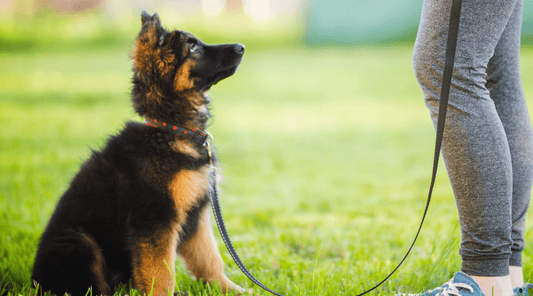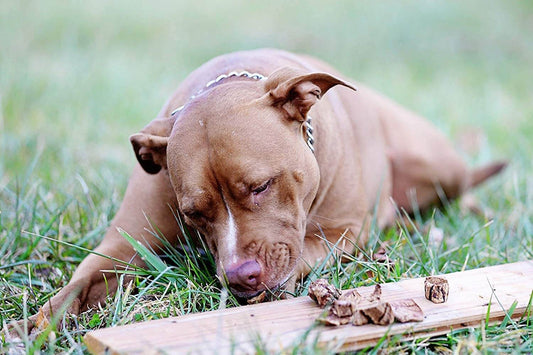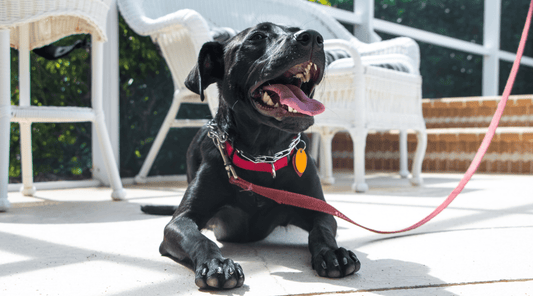
How to Stop a Dog from Chewing on a Leash (Without a Tug-of-War)
Dawn Miller Mar 27, 20254 Minute ReadLearning how to stop a dog from chewing on the leash is dog training 101. If we can't go for a walk like civilized K9 and humans, what can we do?
When I first brought Pixie home from the shelter, walks were a constant tug-of-war. We weren’t even ten steps from the front door when—CHOMP!
She grabbed the leash in her mouth and started thrashing it around like a wild alligator.
Bruno, the picture of calmness, gave me a look like, “Control your child.”
Leash chewing. It’s annoying and frustrating. It can turn a relaxing walk into a battle of wills—and upper body strength.
But why do dogs chew on their leash? And more importantly, how do you stop it?
Why Do Dogs Chew on Their Leash?
Dog leash chewing is not a random behavior. One of these common culprits is most likely to blame:
Teething (for puppies) – Their gums are sore, and they’ll chew anything for relief. Combine that with the fact that they're still learning what a leash is, and it's no wonder they think you've just attached a handy teething leather to their collar.
Excitement – Some dogs get overstimulated on walks and chew out of pure joy. They want to walk, run, and play all at once. If you're taking them to the park, they can't wait.
Frustration or lack of impulse control – Let's get there already. If your dog wants to go, go, go!, they might chomp on the leash when they’re asked to stop or slow down.
Attention-seeking – If chewing the leash gets a reaction out of you, you may be reinforcing the behavior unintentionally.
Playfulness – Some dogs see the leash as a toy automatically and turn walks into a game of tug-of-war.
Past trauma or bad habits — Now, I don't really know much about Pixie's past. But she may have been taught bad walking habits because someone just didn't know any better. Or a leash may have been used the wrong way —jerking or tightly restraining her.
All of these are fixable. So, let's get to it!
How to Stop Dog from Chewing on Leash
1. Try Chew Proof Dog Leash Options
So, in a nutshell, stop making the leash “fun” to chew and give them something better.
Has your dog already turned a few leashes into shredded fabric? It might be time for an upgrade. Until they learn not to chew on your leather, vinyl, and fabric leashes, you may need to opt for:
- Chain leashes – Try chewing on that!
- Heavy-duty nylon with a reinforced core – Tougher than regular nylon and doesn't taste good.
- Biothane leashes – Waterproof, durable, and harder to destroy.
Most dogs will lose interest in chewing with these options. This gives you a window to redirect the behavior so you can go back to a normal leash—that is, unless you like your dog's new punk rocker look.
2. Redirect the Behavior with a High-Value Dog Treat
If your dog yanks the leash, don't yank back. Instead, redirect their focus.
Carry high-value treats (think beef lung bites, not boring kibble).
The second they start chewing the leash, show the treat. But don't give it to them. You don't want them to think you're rewarding chewing.
Say "Leave it" and reward them with high-value dog treats the moment they stop chewing.
Note: If you haven't previously taught your dog the leave it command, teach it in a low-distraction area like a living room without the leash first. I share how to teach "leave it" here.
Some people prefer the command "drop it." The principle is the same, so just pick one and stay consistent.
3. Give Them a Chew Bone Before the Walk
Let them get that chew energy out by learning there are better things to chew.
Give them a long-lasting dog bone for 15-20 minutes before the walk. Chewing also calms hyper dogs down, making them easier to manage on a walk.
K9 Connoisseur’s natural marrow bones are perfect for this—nutrient-rich, delicious, and long-lasting. I can't imagine how I would have gotten through those early days with Pixie without these single-ingredient dog bones.
4. Teach the "Heel" or "Let's Go" Command
Choose one. Either one communicates with your dog that if they want to go, they must walk like a civilized dog—preferably at your side, with a bit of slack in the leash.
I discuss proper heel procedure in this post.
5. Stop and Wait
Don't try to proceed with the walk until the chewing stops. Your dog will need to learn that when they chew and pull, the walk stops.
Dogs love to walk. They want to go, even if they're not doing a good job of communicating that. This can stop many dogs' behavior, especially when you give them a high-value treat when they stop.
Amanda demonstrates how to stop leash pulling in this video.
So, if they yank or chew, stop the walk. When they stop, give them a treat (something small and quick). Start walking again. Repeat as many times as needed. Most dogs will learn this quickly.
It didn't take Pixie long to understand. Irresistible treats make all the difference. Don't insult their intelligence by trying to pass off a kibble as a treat.
High-value treats are something they don't get all the time. They smell amazing—to a dog. I can't smell the treats with my human nose, though. The better the treat, the faster you'll be able to train and the more consistent your dog will become in following commands—even though they won't get a treat every time.
6. Use a Front-Clip Harness to Reduce Frustration
Some dogs chew because they don't understand why you're so slow. A front-clip harness can improve your control and make it harder for your dog to chew on the leash.
It can also reduce frustration when combined with heel command. Your dog learns to feel positive about themselves when they can maintain your pace while walking at your side. It becomes a fun game to them.
The Don'ts of How to Stop Dog from Chewing on Leash
- Don’t yank the leash—stay calm, stop walking, and wait for them to drop it.
- Don’t pull the leash out of their mouth—this can trigger more resistance. And you could break their teeth if you yanked hard enough.
- Avoid saying “No! No! No!” repeatedly—some dogs love the extra attention! You might as well be saying the opposite. Dogs (and small children, by the way) only think in affirmatives. Go ahead! Tell a small child not to do something and see what happens. So, instead, communicate what you want. For example, "Heel"—to your dog, not a child.
Yes, You Can Stop Dog Chewing Tug-of-War
With the right dog training and high-value treats, you and your dog can walk side-by-side, loving walks and where they take you. Join me for K9 Connoisseur's 7-Day Training Challenge to learn more about using positive reward training strategies. You can raise a confident, well-behaved dog.
Available On:


Disclosure: This article may contain affiliate links, which means we may earn a small commission if you make a purchase through these links—at no extra cost to you. We only recommend products we trust and believe will benefit you and your K9.



